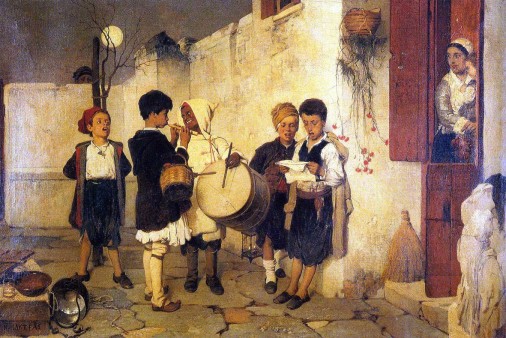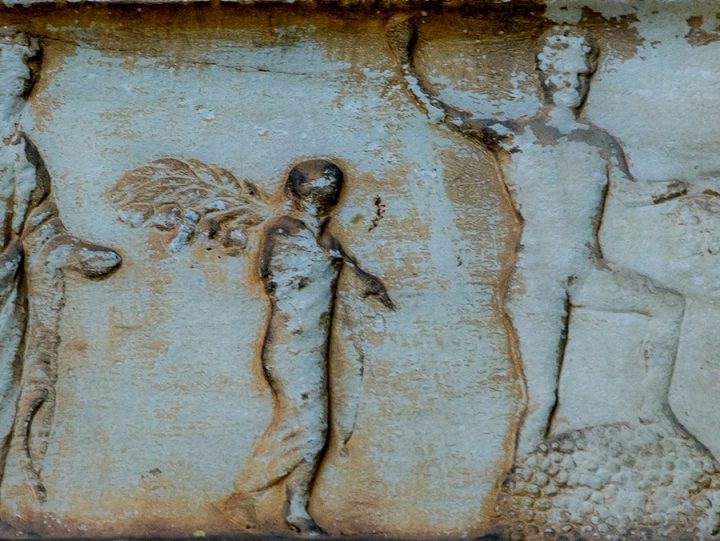In ancient Greece at the end of autumn and at spring it was practiced by children (boys) the ritual of “Eiresione” or Iresione, in which they carried from home to home, some olive branch (or laurel) decorated with red wool and white, various seasonal fruits and little jars of oil and honey, in hopes of receiving presents.
In this way they were thanking Gods (in particular Apollo, as God of the Sun) for the harvest.

The song, attributed to Homer (in Lifes of Homer pseudoerodotea), dates back to the 6th century BC and it is the forefather of the songs of begging perpetuated by the peasant tradition throughout Europe and in particular in the Piedmontese “canto delle uova” and “il canto della Strina” in Magna Graecia.
The beggars promise happiness to those who will give something and and promise of returning each year as the swallow.
“The turrets of a man of infinite might
of infinite acrion, substance infinite,
we make access to; whose whole being rebounds
from earth to heaven, and naught but bliss resounds..“
This garland is clearly the symbol of divinity, the arrival of God and the renewal of the year.
The ritual took place in two main festivals the Pyanepsie in the fall and the Tharghelie in the spring.

The Pyanepsie, in fact, celebrated at the beginning of autumn in honor of Apollo or Helios and the Hore, foresaw that a young man with both living parents would bring an olive branch adorned with woolen bandages, fruits and animal products, called eiresion, which was posted on the gate of the temple of Apollo and on the entrance to the common houses, where it would remain until the following year, when it would be replaced by the new one. Pausanias traces the tradition back to Theseus who, leaving for Crete, had dedicated the branch in the temple of Apollo to Delos, and another would have brought it home when he returned after killing the Minotaur: “on this day we bring the eighion , a branch of olive tree wrapped in wool, as Teseo had once brought the branch of supplicants, full of firstfruits of every kind, to indicate the end of infertility, and sang: “Eiresione for us brings figs and bread of the richest, brings us honey in pots and oil to rub off from the body, Strong wine too in a beaker, that one may go to bed mellow.”
The same branch adorned with first fruits, oil, milk and honey also appears in the Targhelias of April-May, and one might think that it could be tracing an ancient rural custom aimed at propitiating the beginning of the harvest and thanking to its conclusion.(translated from here)
Eirene (Irene) is also the goddess of peace of the group of Hours “… the Goddess who dispenses wealth and makes young people grow …” (Euripides, the Bacchae 419/420) depicted with an olive branch and the cornucopia with little Pluto, the god of wealth, in her arms .

HORAI
It is Dionysus who leads the procession of the Horai, (the Hours) the three young ladies who personify the renewal of the nature, the daughters of Zeus and Themis, the Universal Order.
They are also the personification of the three Seasons: Thallo, the goddess of Spring who presides over the blossoming of plants; Auso or Auxo, which represents the summer luxuriance; Carpo, the goddess of Autumn that represents the maturity and the fruit of the plants.
At first 3 then 4, 10, they became 12 as months and 24 as hours.
The Horai were the guardian virgins of Olympus, with their circular dance (like the solar wheel), which making the door of Olympus appear or disappear in the clouds. They are depicted as they dance around the solar chariot of Apollo.
An idea of how dance took place, it comes from the Romanian folk tradition, with Hora
Sources
http://agiorisnestanis.blogspot.com/2018/07/blog-post.html
http://www.hellenicgods.org/eiraesiohni—eiresione—eiresione
http://thule-italia.com/wordpress/2013/05/15/targelione/
http://www.odysseo.it/eirene-la-dea-della-pace/
https://tanogaboblog.it/portalino/ore-personificazioni-scorrere-tempo/
http://lyra.altervista.org/pdf/rivista/25-36/XXXIII.pdf
